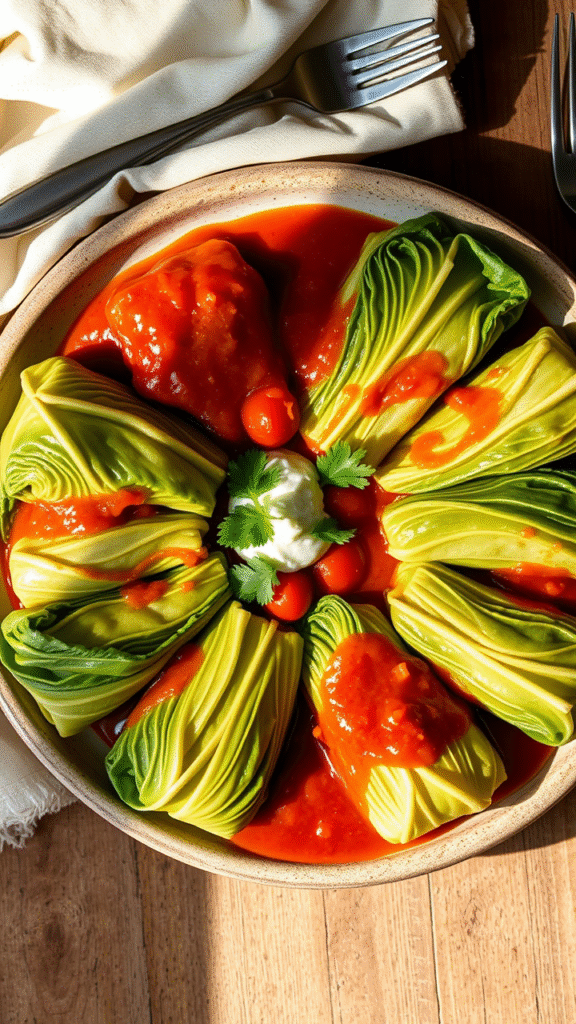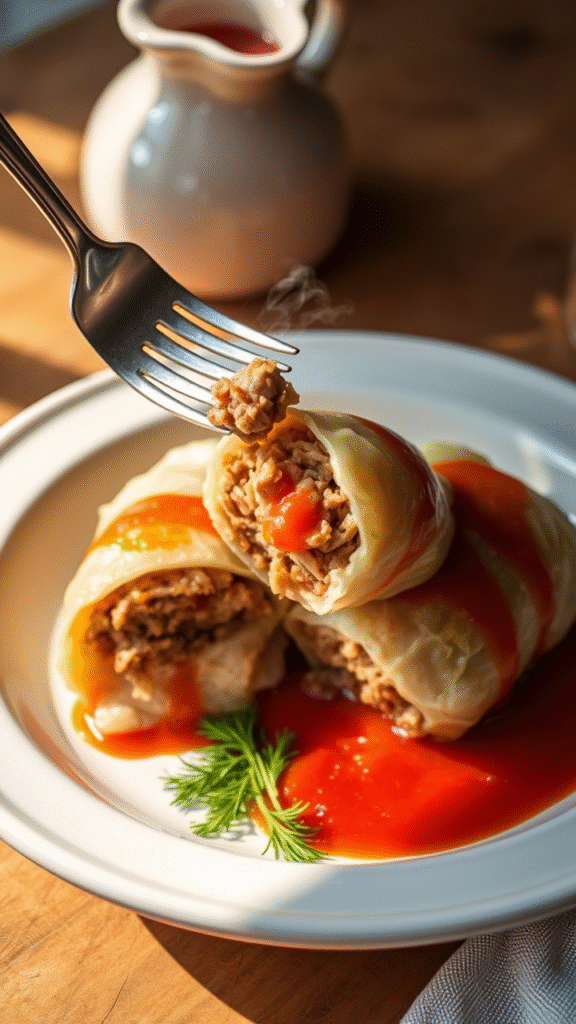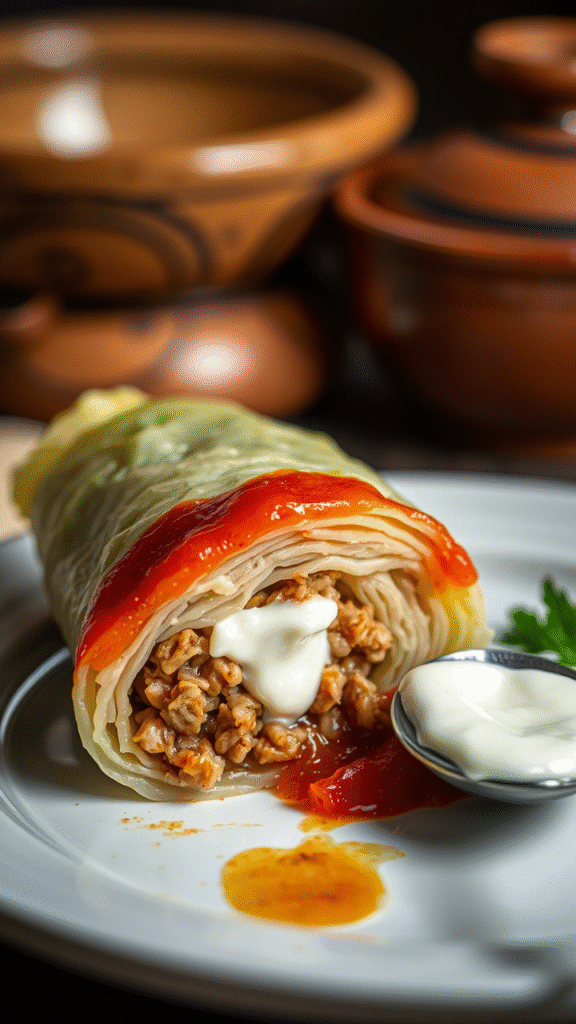Have you ever wrapped a meal inside a leafy green and found yourself transported across cultures, centuries, and kitchens? Stuffed cabbage rolls, those humble bundles of meat, rice, and spices cradled by tender cabbage leaves, have done exactly that for countless food lovers worldwide. This dish isn’t just comfort food—it’s history, science, and technique, all rolled up in one.
What makes stuffed cabbage rolls truly special? For starters, it’s the marriage of simple ingredients transformed through care and method into something profoundly satisfying. The process of blanching cabbage, preparing a seasoned filling, and gently simmering it in a flavorful sauce is a dance of textures and tastes that’s both rustic and refined. It’s a dish beloved from Eastern Europe to the Middle East, each culture adding its own twist, which means there’s no single “right” way—only delicious variations waiting to be explored.
Ingredients & Substitutions: Choosing Your Building Blocks
At its core, stuffed cabbage rolls require just a handful of ingredients, but each component plays a pivotal role.
- Cabbage leaves: Go for a firm, large-headed green cabbage. Freshness matters; older cabbage tends to be bitter and brittle, making rolling tricky. Napa cabbage is a softer, sweeter alternative but changes the texture entirely.
- Ground meat: Traditionally, pork or beef—or a mix of both—gives the rolls their hearty bite. For leaner options, turkey or chicken work fine, though they can be drier. Vegetarians often substitute cooked lentils, mushrooms, or textured vegetable protein for a meatless filling.
- Rice: Short or medium grain works best, as they stick together without becoming mushy. Parboiled rice can be used for a firmer bite. Avoid instant rice; it tends to overcook and lose texture.
- Onions & garlic: Freshness here is non-negotiable. They add sweetness and depth, so don’t skimp.
- Herbs and spices: Fresh parsley and dill elevate the flavor, but dried herbs are fine in a pinch—just use about a third of the quantity of fresh. Paprika (sweet or smoked) is a frequent guest in Eastern European recipes, giving that distinctive earthy warmth.
- Tomato sauce or paste: A rich, acidic element that balances the richness of meat and rice. Homemade tomato sauce with fresh herbs will always outshine canned, but when time’s tight, a good-quality canned product is fine.
Substitutions You’ll Love
- Gluten-free? Use quinoa or cauliflower rice instead of traditional rice.
- Dairy allergy? Some recipes call for sour cream topping; skip or replace with coconut yogurt.
- Low-carb? Skip rice and bulk up the filling with finely grated zucchini or mushrooms.
Choosing fresh, high-quality ingredients is half the battle. Fresh herbs versus dried? Dried herbs pack a concentrated flavor but lose brightness. I usually combine both—fresh at the end, dried in the cooking stage. This layering gives complexity that single-use never achieves.
Step-by-Step Instructions: Mastering the Roll

- Prepping the cabbage
Start by carefully peeling whole leaves from the cabbage head. Core the cabbage first for easier leaf removal. Blanch the leaves in boiling salted water for 2-3 minutes until pliable but not mushy. Cold water shock afterwards stops cooking and preserves that vibrant green. Don’t skip this step—it’s essential for rolling ease. - Preparing the filling
Sauté onions and garlic until translucent. Combine with ground meat, partially cooked rice (parboiled or briefly boiled), herbs, and seasoning in a bowl. Mix gently—overmixing toughens the meat. Add a splash of water or stock to keep it moist. - Rolling technique
Place about 2 tablespoons of filling on the leaf’s base. Fold the sides in, then roll tightly but without squeezing out the filling. If you pack it too tight, the rolls might burst during cooking. - Cooking the rolls
Layer cabbage leaves on the bottom of a heavy pot or Dutch oven to prevent sticking and burning. Arrange rolls seam side down. Pour over your tomato sauce, cover, and simmer gently for about 1 to 1.5 hours. Low and slow is the mantra here—high heat risks tearing the leaves or drying out the filling.
Common Mistakes & Fixes
- Tearing leaves: Often caused by skipping blanching or using old cabbage.
- Dry filling: Partially cooking rice and adding a bit of liquid keeps moisture in balance.
- Falling apart rolls: Rolling too loosely or overfilling can cause this. Practice makes perfect!
Variations to Try
- For a spicy kick, add cayenne or chili flakes to the filling.
- In some Middle Eastern versions, use lamb, pine nuts, and cinnamon for a richer, fragrant profile.
- Replace tomato sauce with a light broth and lemon juice for a fresh, tangy take.
Cooking Techniques & The Science Behind

Why blanch cabbage? It’s all about softening the tough cellulose fibers just enough to roll without tearing. The quick heat exposure loosens leaf structure but retains crispness.
Searing meat before mixing? Some cooks swear by it to seal juices, but in cabbage rolls, raw meat is often mixed with partially cooked rice and cooked slowly, allowing flavors to meld. It’s a more forgiving method.
Simmering rather than baking keeps the rolls tender. The moist heat gently cooks the filling and allows rice to fully absorb flavors. High heat dries the leaves and toughens meat.
Tomato sauce adds acidity, which breaks down connective tissues in meat gently, tenderizing the filling over the long simmer.
A heavy pot like a Dutch oven ensures even heat distribution and prevents hot spots that could burn or overcook parts of the dish.
Serving & Pairing: Elevate Your Presentation

Serve stuffed cabbage rolls warm, ideally with a dollop of sour cream or a sprinkle of fresh herbs for contrast. The vivid red sauce and deep green cabbage make for a striking plate.
Pair them with creamy mashed potatoes or buttery egg noodles. A crisp cucumber salad with vinegar balances the richness beautifully.
Wines? Go for a light red like Pinot Noir or a dry white like Riesling with a hint of sweetness to complement the tomato and meat.
Presentation-wise, serve rolls nestled side-by-side in a shallow bowl, sauce spooned generously over. A rustic loaf of crusty bread finishes the ensemble perfectly.
Wrapping Up: Why Stuffed Cabbage Rolls Remain a Classic
Stuffed cabbage rolls are proof that simple ingredients, handled with care, become extraordinary. It’s a dish that celebrates technique—blanching, gentle rolling, slow simmering—and the magic that happens when flavors meld over time.
The beauty lies in its versatility: tweak the filling, sauce, or herbs to suit your palate or pantry. This is comfort food, culture, and science rolled into one humble but spectacular meal.
If you’re trying this for the first time, take your time with the cabbage leaves—they’re the canvas for everything. Don’t rush the simmering stage; patience is a virtue here. And remember, every pot of stuffed cabbage rolls tells a story—yours is waiting to be written.
Frequently Asked Questions
Q1: Can I prepare stuffed cabbage rolls ahead of time?
Absolutely. They taste even better the next day as flavors deepen. Refrigerate after cooking and reheat gently in the oven or stovetop.
Q2: What’s the best way to store leftovers?
Keep them in an airtight container with sauce. They’ll last up to 4 days in the fridge or can be frozen for up to 3 months.
Q3: Can I use frozen cabbage leaves?
It’s not ideal. Freezing tends to break down the leaves, making them mushy and hard to roll. Always opt for fresh cabbage.
Q4: How do I prevent stuffed cabbage rolls from sticking to the pot?
Line the bottom with extra cabbage leaves or parchment paper, and keep the heat low to avoid burning.
Q5: Is it possible to make stuffed cabbage rolls vegan?
Definitely! Replace meat with a mix of lentils, mushrooms, walnuts, and cooked grains, and use vegetable broth and tomato sauce for cooking.
There you have it. Stuffed cabbage rolls—ancient yet timeless, simple yet complex—are a culinary joy to make and savor. Give ‘em a try and discover why chefs and home cooks alike can’t get enough.

Food lover, recipe creator & the heart behind NoshCrafters.com. Olivia shares mouthwatering, easy-to-make dishes that turn everyday meals into unforgettable bites. When she’s not experimenting in the kitchen, she’s busy plating up inspiration for home cooks everywhere.